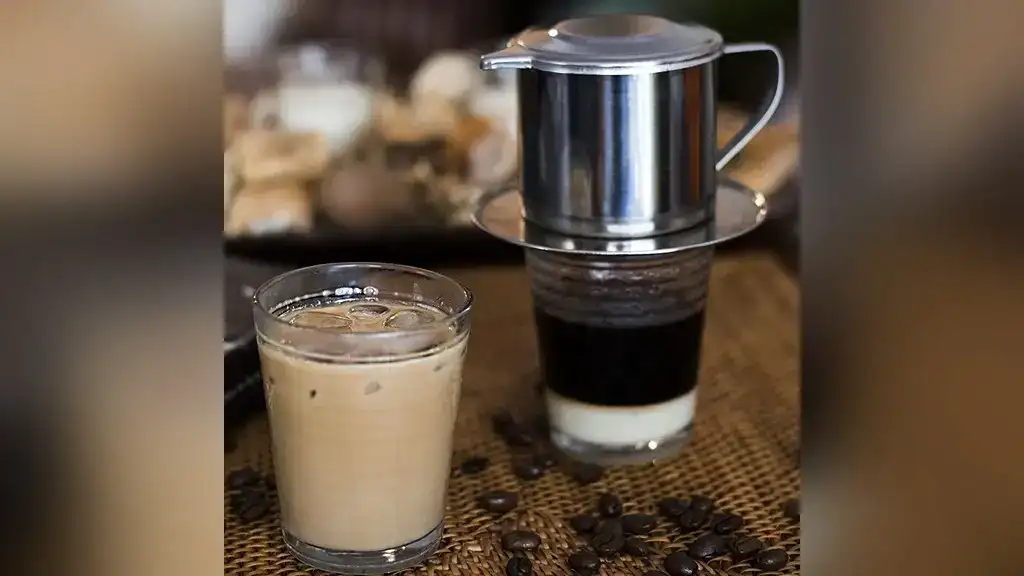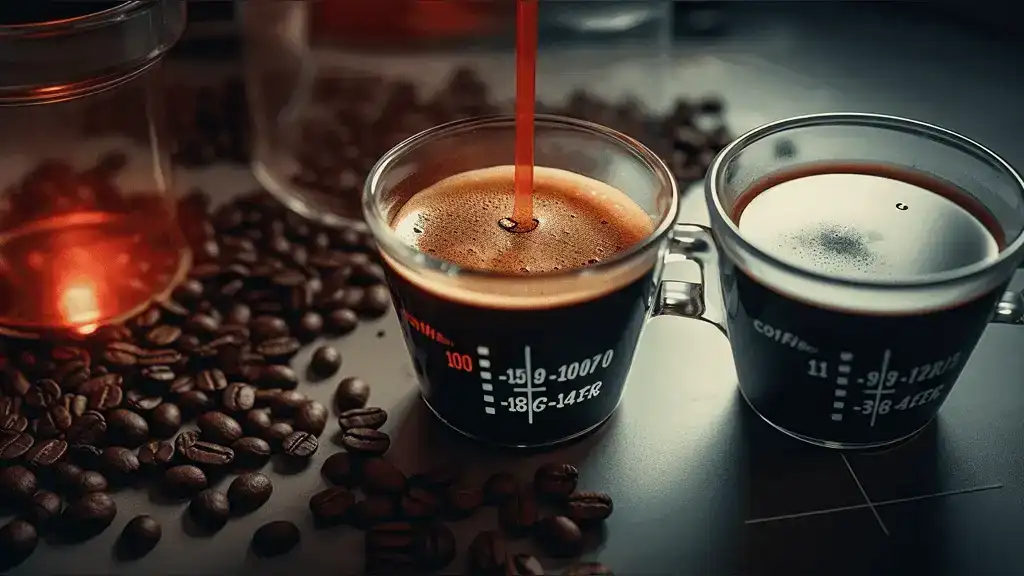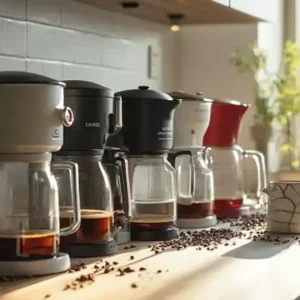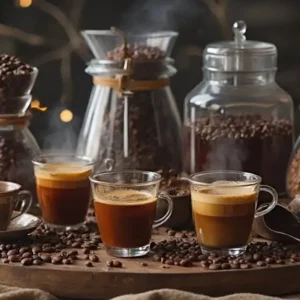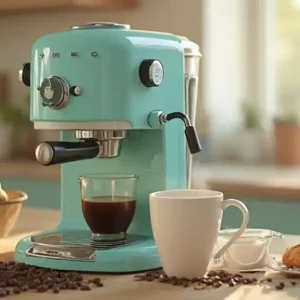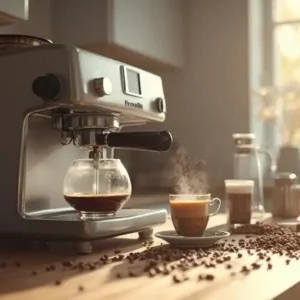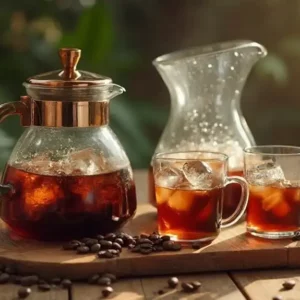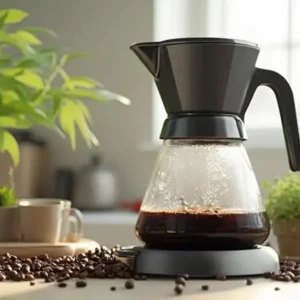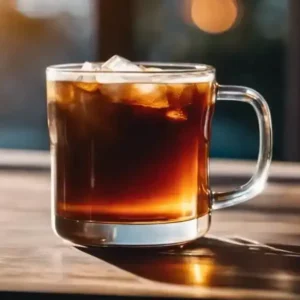To brew better coffee using drip coffee filters, start by selecting the right filter material—paper, metal, or cloth—based on your taste preference. Measure 1-2 tablespoons of coffee per 6 ounces of water and guarantee even distribution in the filter. Secure the filter properly in the basket, and use fresh, filtered water for the best flavor. Clean reusable filters regularly to prevent buildup and always replace paper filters after each use. If you're exploring cold brew, consider using cloth or fine mesh to avoid clogging. Embrace these tips for improved flavor and experience, and you'll discover even more insights ahead.
Key Takeaways
- Choose the right filter type (paper, metal, cloth) based on desired flavor and brewing style for optimal extraction.
- Measure coffee grounds accurately, using 1-2 tablespoons per 6 oz of water for ideal strength.
- Ensure proper filter size for your coffee maker to prevent overflow and ensure even brewing.
- Clean reusable filters regularly and store unused filters in a dry, airtight container to maintain freshness.
- Experiment with different brewing techniques and filter materials to discover unique flavor profiles in your coffee.
How do drip coffee filters work?
Drip coffee filters work by holding coffee grounds while hot water flows over them, extracting flavors as it seeps through.
You'll find that these filters come in various materials, including paper and metal, each affecting the brew's taste differently.
Plus, there are reusable options available, which can save you money and reduce waste over time.
What materials are drip coffee filters made from?
Coffee filters come in various materials, each affecting the brewing process and flavor profile differently. Understanding these filter materials can help you choose the right one for your coffee preferences.
Here are the primary filter types:
- Paper Filters: Disposable and absorbent, they create a clean cup by trapping oils and fine particles.
- Metal Filters: Reusable and eco-friendly, they allow more oils to pass through, resulting in a richer taste.
- Cloth Filters: These provide a balance, filtering oils while being reusable and easy to clean.
- Synthetic Filters: Made from nylon or other materials, they offer durability and can provide a unique flavor.
- Biodegradable Filters: A sustainable option that combines convenience with environmental consciousness.
Choosing the right filter type can enhance your coffee experience.
Are there reusable drip coffee filters?
Many people prefer reusable drip coffee filters for their environmental and cost-saving benefits.
These filters, typically made from stainless steel or fabric, can be washed and reused, making them a sustainable choice compared to disposable paper filters.
When considering reusable options, it's important to evaluate filter comparisons: metal filters allow more oils to pass through, resulting in a richer flavor, while fabric filters may provide a cleaner taste by trapping more sediment.
Reusable filters can save you money over time, as you won't need to purchase replacements regularly.
Ultimately, choosing a reusable drip coffee filter depends on your brewing preferences and the flavor profile you desire in your coffee.
Using Drip Coffee Filters
Using a drip coffee filter is straightforward, but understanding the different types and materials can enhance your brewing experience.
You'll want to take into account whether to reuse filters, as well as the differences between cone and flat-bottom designs for your specific coffee maker.
Choosing the right size filter is also essential to guarantee proper brewing and avoid messy spills.
How do I use a drip coffee filter?
To start brewing with a drip coffee filter, first place the filter in the basket of your coffee maker, ensuring it's properly seated.
Next, measure your coffee grounds according to your desired strength, following common brewing tips for best flavor. Generally, a ratio of one to two tablespoons of coffee per six ounces of water works well.
Pour the grounds into the filter, distributing them evenly. Then, fill the reservoir with fresh, filtered water.
Turn on your coffee maker and let the brewing process begin. As the water seeps through the grounds, you'll be utilizing effective drip filter techniques.
Once brewing is complete, dispose of the used filter and enjoy your freshly brewed coffee!
Can I reuse a drip coffee filter?
Reusing a drip coffee filter is possible, especially if you're using a metal or cloth filter.
These reusable filters are designed to handle multiple uses without compromising the flavor of your coffee. Just make sure to thoroughly clean them after each brew to prevent any lingering coffee sediment from affecting your next cup.
With paper filters, however, it's not recommended to reuse them, as they can break down and may not effectively filter out fine particles.
If you choose to reuse, keep an eye on the filter's condition, and don't hesitate to replace it if it starts to show signs of wear.
Ultimately, the choice of filter impacts both convenience and the quality of your coffee.
What types of materials are drip coffee filters made from?
Drip coffee filters come in a variety of materials, each offering unique benefits and characteristics. Understanding these filter materials can help you choose the right one for your brewing style and desired flavor profile.
- Paper: Disposable and absorbent, paper filters create a clean cup by trapping oils and fine particles.
- Metal: Reusable and durable, metal filters allow more oils through, resulting in a richer flavor.
- Cloth: Often used in some traditional brewing methods, cloth filters provide a balanced extraction while being washable.
- Hemp: Eco-friendly and unique, hemp filters can impart subtle flavors.
- Silicone: Flexible and reusable, they're easy to clean and maintain.
Each material influences brewing characteristics, affecting your coffee's taste and texture, so consider experimenting to find your perfect match.
What is the difference between cone and flat-bottom drip coffee filters?
When choosing between cone and flat-bottom drip coffee filters, it's important to take into account how each design impacts brewing. Cone filters, with their tapered shape, allow for a more concentrated extraction process, often resulting in a bolder flavor. Flat filters, on the other hand, provide a broader surface area for water to flow through, which can lead to a milder taste.
| Feature | Cone Filters | Flat Filters |
|---|---|---|
| Shape | Tapered | Flat |
| Extraction Style | Concentrated | Even |
| Flavor Profile | Bolder | Milder |
Understanding these differences can help you select the filter that best fits your taste preferences and brewing method.
How do I choose the right size drip coffee filter?
Choosing the right size coffee filter is key to brewing a delicious cup of coffee. To guarantee you're using the correct filter, consider the following:
- Know your coffee maker: Different machines require specific drip filter sizes for peak performance.
- Check filter compatibility: Always refer to your coffee maker's manual for recommended filter sizes.
- Consider the brew method: Cone-shaped filters often require different sizes than flat-bottom filters.
- Pay attention to the number of cups: Larger batches may need bigger filters to prevent overflow.
- Experiment: Trying various sizes can help you find the best fit for your taste preferences.
Can I make coffee without a drip coffee filter?
Making coffee without a drip coffee filter is certainly possible, but it requires alternative methods to separate the grounds from the liquid.
You can use coffee filter alternatives like a fine mesh sieve, cheesecloth, or even a clean dish towel. Simply steep your coffee grounds in hot water, then pour the mixture through your chosen filter to catch the grounds.
Brewing techniques vary; for instance, the French press allows you to immerse grounds in water and then press them down, separating them from the liquid without needing a filter.
Each method may yield different flavors and strengths, so feel free to experiment until you find the brewing technique that suits your taste preferences best.
What is a coffee filter basket?
A coffee filter basket is an essential component of drip coffee makers, designed to hold your coffee filter and grounds securely in place during the brewing process.
This basket comes in various coffee filter types, accommodating different styles of filters, such as cone-shaped and flat-bottom options.
When you load your filter into the basket, it guarantees even distribution of water over the grounds, resulting in a well-brewed cup of coffee.
You'll also find different filter paper brands, each offering unique qualities that can influence the flavor and clarity of your brew.
Understanding your coffee filter basket's role helps you optimize your brewing technique for a better coffee experience.
Cleaning and Maintenance of Drip Coffee Filters
Cleaning and maintaining your drip coffee filters is essential for ideal brewing.
You should regularly clean metal filters and replace paper ones to guarantee the best flavor in your coffee.
Additionally, knowing how to store your unused filters can help extend their lifespan and keep your coffee routine hassle-free.
How do I clean a metal drip coffee filter?
To keep your metal drip coffee filter in top shape, rinse it under warm water immediately after each use. This simple cleaning technique prevents coffee oils and grounds from building up, which can affect the flavor of your brews.
If you notice any stubborn residue, use a soft sponge or dishcloth with a mild detergent to gently scrub the filter. Rinse it thoroughly to remove any soap, ensuring there's no lingering taste.
For enhanced filter longevity, avoid using abrasive materials that could damage the mesh. Regular cleaning won't only maintain the quality of your coffee but also extend the life of your metal filter, making it a worthwhile investment for any coffee enthusiast.
How often should you change your drip coffee filter?
Changing your drip coffee filter regularly is key to ensuring ideal flavor and hygiene in your coffee. For disposable paper filters, you should replace them with each brew to maintain freshness.
Reusable filters require regular cleaning, ideally after every use, to avoid flavor contamination. Here's a quick guide to help you with drip filter maintenance:
- Change paper filters after each use.
- Clean reusable filters thoroughly after each brew.
- Inspect reusable filters for wear and tear regularly.
- Replace metal or cloth filters every few months, depending on usage.
- Always be mindful of any lingering odors or tastes.
How do I store unused drip coffee filters?
Proper storage of unused drip coffee filters is essential for keeping them in good condition and ensuring they remain effective.
To achieve ideal coffee filter storage and filter organization, consider these tips:
- Keep them in a dry place to prevent mold and mildew.
- Store filters in their original packaging or an airtight container.
- Avoid exposure to direct sunlight, which can weaken the paper.
- Use a drawer or shelf dedicated to coffee supplies for easy access.
- Label containers if you have different filter types to streamline your brewing process.
What is the lifespan of a reusable drip coffee filter?
The lifespan of a reusable drip coffee filter can vary considerably based on the material and how well you maintain it. Generally, metal filters can last for many years if you clean them properly after each use, while fabric filters may last a year or two before they start to wear out.
To extend your filter's lifespan, rinse it thoroughly after brewing to prevent coffee oils from building up. You'll appreciate the reusable benefits, such as reduced waste and cost savings over time.
Remember that proper maintenance is key to enjoying the best flavor from your coffee. By taking care of your filter, you can guarantee it serves you well for countless brews.
Flavor and Brewing Impact of Drip Coffee Filters
When using drip coffee filters, you might wonder how they influence the taste of your coffee.
The type of filter you choose can greatly impact the richness of flavor, so it's worth exploring options like paper versus metal filters.
Additionally, consider factors like the brewing temperature and whether flavored filters might enhance your coffee experience.
Do drip coffee filters affect the taste of coffee?
Drip coffee filters can greatly influence the taste of your coffee, as they determine which oils and fine particles get through during brewing. Your drip filter preferences play an essential role in the final flavor profile of your cup.
For instance, paper filters absorb more oils, resulting in a cleaner, lighter taste. In contrast, metal filters let more oils pass through, creating a richer, fuller-bodied flavor. The filter flavor impact can be subtle yet significant, affecting everything from aroma to mouthfeel.
What is the best type of drip coffee filter for a rich flavor?
To achieve a rich flavor in your coffee, using a metal drip coffee filter is often your best bet. Unlike paper filters, metal filters allow more oils to pass through, enhancing flavor extraction.
When considering your options, here's a brief coffee filter comparison:
- Metal filters: Provide a fuller body and richer flavor.
- Paper filters: Absorb oils, resulting in a cleaner cup.
- Cloth filters: Offer a middle ground, allowing some oils while filtering out fines.
- Reusable filters: Eco-friendly and can enhance flavor over time.
- Single-use filters: Convenient but may limit flavor complexity.
Choosing a metal filter can greatly improve your brewing experience, ensuring a robust and flavorful cup every time.
Are there flavored coffee filters available?
You might be surprised to learn that flavored coffee filters are available on the market.
These specialty filters come in various flavored options, such as vanilla, hazelnut, and caramel, designed to enhance your brewing experience. When you use these filters, the flavor infuses into your coffee as hot water passes through the grounds. This method can provide a subtle, consistent flavor without needing flavored creamers or syrups.
However, it's crucial to reflect on how these flavors might interact with your coffee beans, as some combinations may not result in a harmonious taste.
If you're looking for a unique twist in your morning brew, experimenting with flavored coffee filters can add an exciting dimension to your coffee routine.
What should you look for in a good drip coffee filter?
When selecting a good drip coffee filter, several key factors influence both flavor and brewing efficiency. Understanding different drip filter types and their impact on brewing techniques can greatly enhance your coffee experience.
Here are some important considerations:
- Material: Choose between paper, metal, or cloth filters based on your preference for flavor and sustainability.
- Size: Verify the filter fits your coffee maker properly to avoid leaks and messes.
- Thickness: Thicker filters can trap more oils, resulting in a cleaner cup, while thinner ones may allow more flavor to pass through.
- Flavor impartation: Some materials might affect the taste; for instance, paper filters may absorb oils.
- Reuse options: Consider whether you want a disposable or reusable filter for convenience and cost-effectiveness.
Is there a specific temperature for brewing coffee with a drip filter?
Brewing coffee with a drip filter requires precision, including perfect water temperature for the best flavor extraction.
The recommended brewing temperature typically falls between 195°F and 205°F (90°C to 96°C). This range guarantees ideal coffee extraction, allowing the flavors and oils to dissolve properly while avoiding over-extraction, which can lead to bitterness.
If your water is too hot, it may scorch the grounds, while water that's too cool can result in a weak, under-extracted brew.
To achieve this perfect brewing temperature, consider using a thermometer or a kettle with temperature control.
Drip Coffee Filters and Cold Brew
If you're wondering whether you can use a drip coffee filter for cold brew, the answer is yes, though it might clog with coarse grounds.
Using a drip filter generally won't alter the flavor much, but if it does clog, gently shaking it can help.
You might also consider alternatives like a cloth coffee sock if you find filtering takes too long.
Can you use a drip coffee filter for cold brew?
Using a drip coffee filter for cold brew is definitely possible and can yield great results. This method allows you to separate coarse coffee grounds from the brewed liquid effectively.
However, you might encounter some clogging since drip filters are designed for finer particles. To enhance your cold brew techniques, consider monitoring the filtering process closely and agitate the filter gently if it starts to clog.
If you're looking for filter alternatives, options like cloth coffee socks or fine mesh sieves might be more suitable for handling coarser grounds. Experimenting with different filters can help you discover the best approach for your cold brew, ensuring a smooth and enjoyable drink every time.
Does using a drip filter affect cold brew flavor?
While some coffee enthusiasts might worry about the impact of a drip filter on cold brew flavor, you'll likely find that it doesn't greatly alter the taste.
Using a drip coffee filter generally results in a cleaner, smoother beverage, as it effectively removes fine particles and sediment. This means you can enjoy a more refined drinking experience without significant flavor impact.
Many users appreciate the clarity that a drip filter provides, enhancing the overall quality of their cold brew.
While preferences vary, experimenting with different filters might help you determine what works best for your taste.
Ultimately, the choice of using a drip filter can enhance your cold brew without compromising its essential flavors.
What to do if the drip filter clogs?
A clogged drip coffee filter can slow down your cold brew process, but there are effective ways to handle it. Start by gently shaking or agitating the filter to help the liquid flow through.
If that doesn't work, consider these clogging solutions for better filter maintenance:
- Use coarser coffee grounds to minimize clogging.
- Try a double filter method for better flow.
- Clean your filter regularly to prevent buildup.
- Experiment with different filter types suited for cold brew.
- Adjust your brewing time to avoid over-extraction.
Are there alternatives to drip filters for cold brew?
If you're looking for alternatives to drip filters for cold brew, several options can enhance your brewing experience.
These alternative filtering methods can help you avoid clogging and improve the overall taste of your cold brew. Here are some popular choices:
- Cloth coffee sock: Perfect for steeping and filtering coarsely ground coffee.
- Fine mesh sieve: Allows for quick draining while capturing most grounds.
- Nut milk bags: Great for filtering out coffee grounds effectively.
- AeroPress: Offers a unique cold brew technique with fine filtration.
- Hemp liners: Eco-friendly and can add subtle flavors to your brew.
Experimenting with these alternatives can elevate your cold brew techniques and help you discover what works best for your taste preferences.
How long does filtering cold brew take?
Filtering cold brew can vary in time depending on the method you use, especially when utilizing drip coffee filters.
Generally, you can expect the filtering process to take anywhere from 30 minutes to a couple of hours. The size of your batch and the coarseness of your coffee grounds will also play significant roles in determining this time.
If you're using common cold brew techniques, like a simple pour-over, it may take longer due to potential clogging.
For faster results, consider filter alternatives like a fine mesh sieve or a coffee sock. These options can help reduce waiting time while effectively separating the grounds, allowing you to enjoy your cold brew sooner.
Should you use multiple filters for cold brew?
Using multiple filters for cold brew can be a smart strategy to enhance the brewing process. By employing filter combinations, you can greatly reduce clogging and improve the overall clarity of your brew.
For instance, layering two or more drip coffee filters can help trap finer coffee particles while allowing the liquid to flow more smoothly. This technique is particularly useful when using coarser grounds, which are common in cold brew recipes.
Experimenting with different cold brew techniques and filters can lead to a more satisfying cup. Just remember, while multiple filters can help, they may also slow down the brewing process, so be patient as your cold brew develops its rich, flavorful profile.
Eco-Friendly Options for Drip Coffee Filters
If you're looking for eco-friendly options for your drip coffee filters, there are several choices available.
Many brands offer biodegradable paper filters that can be composted after use, making them a sustainable alternative to traditional filters.
Additionally, reusable metal or cloth filters not only reduce waste but also enhance the flavor of your coffee by allowing more oils to pass through.
Are there eco-friendly drip coffee filters?
While many coffee lovers rely on traditional paper filters, eco-friendly drip coffee filter options are becoming increasingly popular.
These alternatives not only enhance your brewing experience but also contribute to a more sustainable coffee culture. Here are some eco-friendly choices you can consider:
- Reusable metal filters: Made from stainless steel, these filters are durable and reduce waste.
- Cloth filters: Often made from organic cotton, they're washable and biodegradable.
- Compostable paper filters: Look for brands using sustainable materials that break down easily.
- Hemp filters: These biodegradable options are both effective and environmentally friendly.
- Bamboo filters: Sourced from renewable bamboo, they offer a sustainable solution for brewing.
Can you compost paper coffee filters?
Composting paper coffee filters is a great way to reduce waste and enrich your garden soil. When you dispose of filters in your compost bin, you contribute to the breakdown of organic materials, which enhances nutrient cycling.
The composting benefits include improved soil health and moisture retention, making your garden more productive. Just make certain your filters are unbleached and free from synthetic materials to guarantee they decompose properly.
It's also important to remove any coffee grounds, as they can attract pests if left in the compost. So, when you're done brewing, consider filter disposal through composting instead of tossing them in the trash.
This simple change can lead to a more eco-friendly lifestyle.
What are the benefits of using drip filters?
Using drip filters offers several benefits that enhance your coffee brewing experience, especially when considering eco-friendly options.
These filters not only contribute to a cleaner brew but also align with sustainable practices. Here are some key filter benefits:
- They reduce sediment, giving you a smoother cup of coffee.
- Many reusable filters are available, cutting down on waste.
- They allow for precise brewing techniques, improving flavor extraction.
- Filters made from natural materials are compostable and environmentally friendly.
- Using the right filter can enhance the overall quality of your brew.
Conclusion
To sum up, choosing the right drip coffee filter can truly transform your brewing experience. Just as a painter selects their brush for the perfect stroke, you too can elevate your coffee with thoughtful filter selection. Whether you prefer the clarity of paper or the durability of metal, understanding your options is key. By applying these tips, you'll not only improve flavor but also enhance the joy of each cup you brew. Enjoy the journey to your perfect coffee!


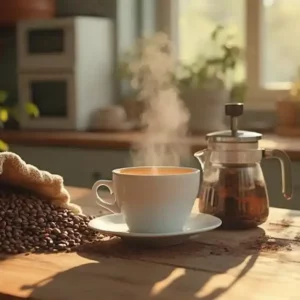


![24 Best Coffee Beans for Drip Coffee: ([year]) Unveiling the Top Picks Best-Coffee-Beans-For-Drip-Coffee-featured-image-1](https://coffeescan.com/wp-content/uploads/Best-Coffee-Beans-For-Drip-Coffee-featured-image-1.webp)
